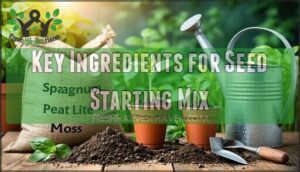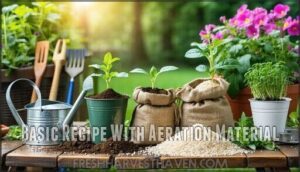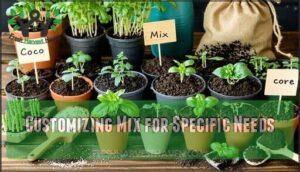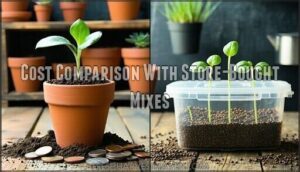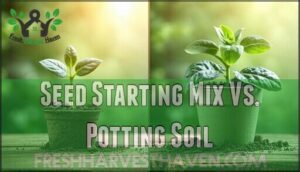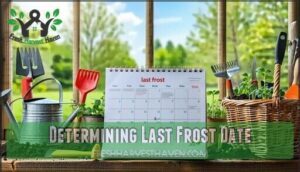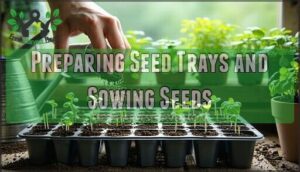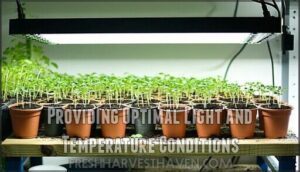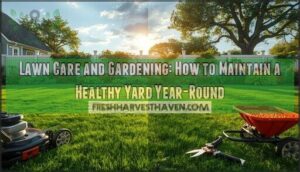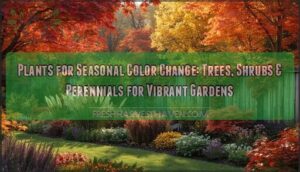This site is supported by our readers. We may earn a commission, at no cost to you, if you purchase through links.
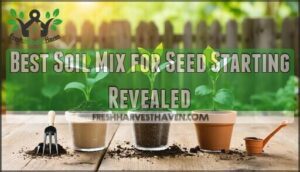
This 1:1:1 ratio creates the perfect balance – loose enough for delicate roots to push through, yet stable enough to hold moisture without becoming waterlogged.
You can’t just grab regular potting soil; it’s too heavy and nutrient-rich for tender seedlings.
Think of it like baby food versus a steak dinner – your seeds need something gentler.
Store-bought mixes work, but making your own saves money and gives you complete control over what goes into your plants’ first home.
Table Of Contents
- Key Takeaways
- Benefits of Seed Starting Mix
- Key Ingredients for Seed Starting Mix
- DIY Seed Starting Mix Recipes
- Top 8 Best Soil Mix for Seed Starting
- 1. Premier Horticulture Pro Moss Peat Moss
- 2. GROW!T Premium Coco Coir Growing Media
- 3. Espoma Organic Perlite Soil Amendment
- 4. Espoma Organic Vermiculite Soil Amendment
- 5. Natural Compost Mix for Gardens
- 6. Organic Garden Lime Soil Amendment
- 7. Organic Worm Castings Fertilizer Mix
- 8. Organic Kelp Meal Plant Fertilizer
- Seed Starting Mix Vs. Potting Soil
- Choosing The Right Seed Starting Mix
- Seed Starting Process and Tips
- Frequently Asked Questions (FAQs)
- What type of soil is best for seed germination?
- What is the best soil to sow seeds in?
- What medium is best for starting seeds?
- What potting mix to use for seeds?
- How long does homemade seed starting mix last?
- Can you reuse seed starting mix multiple times?
- Whats the ideal pH for seed starting mix?
- How do you sterilize homemade seed starting mix?
- When should you fertilize seedlings in starting mix?
- Conclusion
Key Takeaways
- You’ll want to create a seed starting mix with a 1:1:1 ratio of sterile seed starting medium, drainage material, and moisture-retaining ingredients to give your seeds the best chance to germinate and grow into healthy seedlings.
- When choosing a seed starting mix, you should opt for a sterile , well-draining mix that’s rich in organic matter, and consider making your own mix to save money and control what goes into it.
- You should sterilize your homemade seed starting mix by baking it in a 300°F oven for 30 minutes to kill pathogens and pests, and reuse it periodically to maintain sterility and ideal growing conditions.
- You’ll need to fertilize your seedlings once they’ve got two sets of leaves, typically 1-2 weeks after germination, using a balanced , water-soluble fertilizer at half strength to promote healthy growth and development.
Benefits of Seed Starting Mix
You’ll find that using a seed starting mix offers several benefits, including cost savings and ideal growing conditions.
Seed starting mix boosts germination and growth with ideal conditions
By choosing the right mix, you can provide your seeds with the best chance to germinate and grow into healthy seedlings.
Choose the right mix for healthy seedlings to germinate and thrive
Cost Savings
By making your own DIY mix, you can substantially reduce costs.
A homemade potting mix is a cost-effective alternative, offering savings tips and cheap alternatives to store-bought seed starting mix, making it a budget option for gardeners seeking to reuse seed starting mix and create a DIY, cost-effective solution.
Using proper seed starting methods is essential for ideal germination and growth.
Organic and Chemical-Free Ingredients
You prefer organic and chemical-free ingredients for seed starting. Here are benefits:
- Natural Fertilizers
- Organic Compost
- Chemical Free options, promoting sustainable gardening with eco-friendly organic seed mix and coconut coir.
Optimal Fluffiness, Drainage, and Moisture Retention
You’ll want a seed starting mix with ideal fluffiness, drainage, and moisture retention.
| Seed Texture | Water Balance | Soil Structure |
|---|---|---|
| Fine | High | Loose |
| Medium | Medium | Medium |
| Coarse | Low | Dense |
| Loose | High | Aerated |
| Dense | Low | Compacted |
Key Ingredients for Seed Starting Mix
You’re looking for the best soil mix for seed starting, and this is vital to know.
You’ll be using ingredients like sphagnum peat moss, perlite, and vermiculite to create a mix that promotes healthy seedling growth.
Sphagnum Peat Moss and Coco Coir
Two powerhouse ingredients form your seed starting mix foundation.
Sphagnum peat moss offers superior moisture retention with acidic pH levels (3.0-4.0), while coco coir provides neutral pH (5.7-6.5) and faster saturation.
Both create ideal moisture levels for seed germination, though coco coir’s renewable nature makes it environmentally friendlier than peat moss harvested from fragile bog ecosystems.
Gardeners can learn more about the benefits and drawbacks of each material by considering gardening supplies, including the superior moisture retention of peat moss and the neutral pH of coco coir, which are key to seed germination.
Perlite and Vermiculite
Perlite and vermiculite transform your seed starting mix into a powerhouse growing medium.
These volcanic minerals create the perfect balance between drainage and moisture retention that seedlings crave.
Perlite Benefits for superior soil aeration:
- Prevents drowning disasters – Creates air pockets that stop root rot before it starts
- Lightweight champion – Won’t crush delicate seedling roots under heavy soil weight
- Drainage superhero – Whisks away excess water while maintaining essential moisture levels
Vermiculite Uses for ideal seed germination:
Mix ratios matter: use equal parts perlite and vermiculite in your soilless mix for best results.
Understanding seed starting basics is vital for achieving successful germination and healthy seedling growth.
Lime and Compost
You add lime to adjust pH balance and compost for nutrient cycling in your seed starting mix, enhancing soil structure for healthy growth.
While also considering compost tea as an organic potting mix alternative to garden soil blend, you use these elements to support plant development.
DIY Seed Starting Mix Recipes
You can create your own DIY seed starting mix by combining ingredients like peat moss, perlite, and vermiculite.
By making your own mix, you’ll have control over the ingredients and can customize it to meet your specific seed starting needs.
Basic Recipe With Aeration Material
You’ll create a basic seed mix recipe using aeration materials.
Here are key ingredients:
- Perlite
- Vermiculite
- Coco coir, for ideal soil structure and mix ratios, enhancing DIY seed starting mix and potting soil recipe with gardening tips.
Customizing Mix for Specific Needs
Based on your specific crop needs, you’ll want to adjust your seed starting mix ratios for ideal germination. Different seeds thrive with customized custom recipes that account for their unique requirements.
Using a well-draining seed starting mix is essential for healthy root development.
| Seed Type | Mix Adjustment | Soil pH Range | Purpose |
|---|---|---|---|
| Tomatoes | 50% coco coir, 30% perlite, 20% compost | 6.0-6.8 | Fine texture for delicate roots |
| Squash | Add 25% worm castings | 6.0-7.0 | Extra nutrients for heavy feeders |
| Lettuce | 60% peat moss base | 6.0-7.0 | High moisture retention |
| Sunflowers | Extra 20% perlite | 6.0-7.5 | Improved drainage for large seeds |
Your DIY seed starting recipe should match each crop’s specific water and nutrient needs, using a targeted approach that beats generic potting soil every time, ensuring healthy root development and ideal germination.
Cost Comparison With Store-Bought Mixes
When comparing DIY savings against store-bought options, you’ll discover significant cost-effectiveness with homemade seed starting mix.
Budget-conscious gardeners can create custom mix recipes for roughly $8 per cubic foot, while commercial alternatives cost $20.
This price comparison reveals DIY methods offer 60% savings. Your cost analysis shows initial ingredient investment pays off through multiple seasons of cost-effective growing.
Using a proper DIY Soil mix is essential for healthy plant growth and health.
Top 8 Best Soil Mix for Seed Starting
You’ll want to choose the right ingredients to create a seed starting mix that gives your seedlings the best chance at healthy growth.
Here are eight essential components that form the foundation of any successful seed starting blend.
1. Premier Horticulture Pro Moss Peat Moss
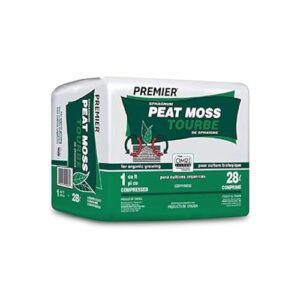
Premier Horticulture Pro Moss Peat Moss stands out as your go-to foundation ingredient for seed starting success.
This 100% natural, organic soil conditioner delivers exceptional water-holding capacity while maintaining proper aeration around delicate seedlings.
You’ll appreciate its pest-free, odor-free composition that creates an ideal germination environment.
The 17-pound cubic foot package offers excellent value compared to full-sized bales.
Its slow moisture absorption and release promotes steady seed growth without waterlogging.
This sustainably harvested peat moss improves soil structure and reduces irrigation frequency, making it perfect for budget-conscious gardeners seeking reliable results.
Best For: gardeners seeking a reliable, natural, and organic soil conditioner for seed starting, lawn maintenance, and gardening tasks.
- Package design may vary, potentially differing from expectations
- May be available at lower prices locally, affecting overall value
- Limited to a 17-pound package size, which may not be suitable for large-scale gardening projects
- Improves soil structure and fertility, promoting optimum plant growth
- Reduces the need for frequent irrigation, conserving water
- Provides a pest-free and odor-free composition, ideal for seed germination
2. GROW!T Premium Coco Coir Growing Media
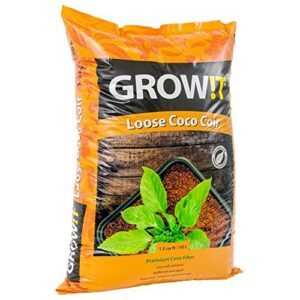
While traditional peat moss dominates seed starting, GROW!T Premium Coco Coir offers a sustainable alternative that’s changing the game.
This 100% natural coconut husk medium provides excellent water retention while maintaining superior aeration for delicate seedling roots.
You’ll appreciate its low EC and stable pH, making it ideal for hydroponic systems. The buffered formula includes essential calcium and magnesium, displacing harmful sodium.
Ready-to-use straight from the bag, it’s light and fluffy without the usual soaking hassle. Your seedlings will thrive in this sterile, gnat-free environment.
Best For: Gardeners and indoor growers seeking a sustainable, easy-to-use seed starting and hydroponic medium that promotes healthy root growth.
- Ready-to-use, light, and fluffy texture promotes strong root development and prevents rot.
- Buffered with calcium and magnesium, ensuring low EC and stable pH for reliable growth.
- Sterile and free from gnats, mold, and other contaminants.
- Higher shipping costs may apply, especially for larger or international orders.
- The large bag size can be surprising and may be more than some users need.
- Mixed results reported in deep water culture (DWC) systems compared to traditional coco coir.
3. Espoma Organic Perlite Soil Amendment
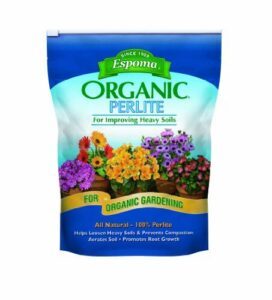
Espoma’s organic perlite transforms heavy soil into a well-draining paradise for your seedlings.
This lightweight volcanic material creates essential air pockets that prevent waterlogged roots and promote healthy growth. You’ll mix one part perlite with one part soil for ideal drainage.
While it’s dusty during application, wearing a mask solves this minor inconvenience. The 100% pure formula contains no chemical additives, making it perfect for organic gardening.
Though pricier than conventional options, you’re investing in superior root oxygenation that produces stronger, healthier seedlings every time.
Best For: organic gardeners who want to improve soil drainage and aeration for healthier plant growth.
- Improves soil drainage and aeration for healthier plant growth
- 100% pure and free from chemical additives, making it perfect for organic gardening
- Creates essential air pockets that prevent waterlogged roots and promote healthy growth
- Can be dusty during application, requiring a mask to avoid inhaling fine particles
- More expensive than conventional perlite options
- Non-resealable packaging can be inconvenient for storage and handling
4. Espoma Organic Vermiculite Soil Amendment
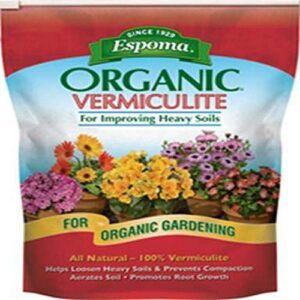
You’re considering Espona Organic Vermiculite Soil Amendment for seed starting.
This 100% natural vermiculite improves soil structure, aeration, and water retention.
It’s ideal for organic gardening, promoting healthy root growth and preventing compaction.
Use it alone or blended with other ingredients to create a customized mix, enhancing germination rates and seedling vigor.
Best For: organic gardeners and seed starters who need a natural soil amendment to improve soil structure, aeration, and water retention.
- More expensive than some alternative soil amendments
- Recent reviews indicate a possible change in texture from coarse to finer
- Requires careful handling to avoid dust and blow-away on windy days
- Improves soil structure and prevents compaction
- Enhances germination rates and seedling vigor
- Suitable for organic gardening and certified organic production
5. Natural Compost Mix for Gardens

For your seed starting mix, natural compost delivers the organic punch your seedlings crave.
This nutrient-rich blend contains green-fed earthworm castings, alfalfa meal, and kelp meal that’ll supercharge germination rates.
You’ll want to mix it 50:50 with browns and greens for ideal results.
Add a natural activator like aged manure to boost the composting process, but avoid fresh manure that can burn delicate roots.
This all-purpose amendment improves soil structure while providing essential nutrients for healthy seedling development, making it a crucial component for healthy seedling growth.
Best For: Gardeners seeking a nutrient-rich, organic compost to boost soil health and improve seedling growth.
- Rich in organic nutrients like worm castings, alfalfa meal, and kelp meal
- Improves soil structure and fertility for gardens, flower beds, and vegetables
- Flexible use for mulching, planting, and compost tea
- Quality and consistency may vary between bags
- Higher price compared to generic or local options
- May contain rocks, pebbles, or twigs in some batches
6. Organic Garden Lime Soil Amendment
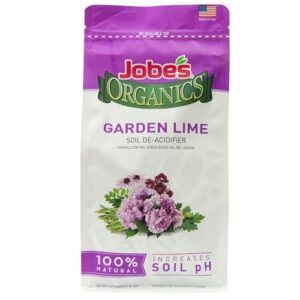
Most gardeners overlook this essential pH-balancing ingredient when mixing their seed starting medium.
You’ll need organic garden lime to neutralize acidic soils and create ideal growing conditions for your seedlings.
This pelletized soil amendment raises pH levels between 6.0-7.0, where most plants thrive.
The granular form distributes evenly without dust or mess, making application straightforward.
It’s OMRI-listed for organic gardening and safe around kids and pets.
Add lime to your seed starting mix when dealing with naturally acidic soil conditions, ensuring an ideal environment for your plants to grow, with the right growing conditions.
Best For: Gardeners with acidic soils seeking an organic, safe, and effective way to raise soil pH for better plant growth.
- OMRI-listed and completely organic; safe for kids and pets.
- Pelletized, dust-free granules ensure even, mess-free application.
- Improves nutrient availability and plant health, particularly for crops like hydrangeas and blueberries.
- Slow results, taking 3-4 months to see noticeable pH changes.
- Packaging may sometimes be subpar or poorly sealed.
- Not suitable for applications that require powdered lime (e.g., some orchard uses).
7. Organic Worm Castings Fertilizer Mix
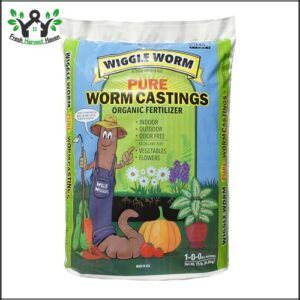
Beyond traditional compost, organic worm castings represent nature’s premium fertilizer for seed starting mixes.
These nutrient-rich castings contain beneficial microbes and enzymes that enhance soil structure, creating better water retention and aeration.
You’ll find they’re particularly effective when mixed at a 1:3 ratio with potting soil for container gardens.
The fine, football-shaped particles improve root development while providing slow-release nutrients.
This OMRI-listed amendment retains moisture better than standard mixes, supporting stronger germination rates and healthier seedlings throughout their early growth stages, with better water retention.
Best For: gardeners and plant enthusiasts who want a natural, odorless, and non-toxic fertilizer that promotes healthy plant growth and improves soil structure.
- Improves soil aeration and water retention capacity
- Provides slow-release nutrients for long-lasting benefits
- Easy to use and cost-effective, with small amounts providing significant results
- Some users may experience minor odor issues despite the product being described as odorless
- May require frequent application for optimal results
- Limited size options available for purchase
8. Organic Kelp Meal Plant Fertilizer
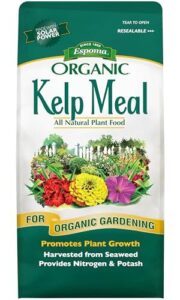
You’ll find Organic Kelp Meal Plant Fertilizer boosts seedling growth with its rich nutrient content.
It contains over 60 minerals, 12 vitamins, and 21 amino acids, promoting healthy development.
This fertilizer enhances soil structure, improves water retention, and increases disease resistance, making it an excellent addition to your seed starting mix.
It’s a sustainable, eco-friendly option for organic gardening.
Best For: organic gardeners, farmers, and nurseries looking for a sustainable and eco-friendly fertilizer to promote healthy seedling growth and development.
- Enhances soil structure and improves water retention
- Increases disease resistance and promotes healthy development
- Sustainable and eco-friendly option for organic gardening
- May have a strong ocean scent
- Requires careful measurement to avoid stressing plants
- Can be more expensive than synthetic fertilizers
Seed Starting Mix Vs. Potting Soil
You’re about to learn the key differences between seed starting mix and potting soil.
When you choose the right mix, you’ll give your seeds the best chance to germinate and grow into healthy seedlings.
Texture and Composition Differences
You’ll notice seed starting mix has a finer texture than potting soil.
| Seed Texture | Mix Composition | Soil Structure |
|---|---|---|
| Fine | Balanced | Well-draining |
| Medium | Varied | Moisture-retentive |
| Coarse | Simple | Compact |
Nutrient Content and Seedling Needs
You’ll want a seed starting mix with balanced nutrient content for ideal seedling growth.
| Seed Nutrition | Nutrient Balance | Soil pH |
|---|---|---|
| Macronutrients | N-P-K ratio | 5.5-6.5 |
| Micronutrients | Calcium, Magnesium | 6.0-6.5 |
| Fertilizer Needs | Low to moderate | 5.5-6.0 |
| Organic Gardening | Natural ingredients | 6.0-6.5 |
| Seedling Growth | Balanced nutrients | 5.5-6.5 |
Understanding the soil composition matters is vital for creating an ideal seed starting mix with balanced nutrients for optimal growth.
Choosing The Right Seed Starting Mix
You’re looking for the right seed starting mix to give your seeds the best chance to grow.
By choosing a mix that’s sterile, well-draining, and rich in organic matter, you can create an ideal environment for your seeds to germinate and thrive.
This approach allows you to provide your seeds with the best conditions for growth.
Organic Vs. Non-Organic Options
A solid seed starting mix gives you real control.
Organic options keep things Chemical Free and boost Sustainable Gardening efforts, letting you skip synthetic junk.
Natural Ingredients in a soilless mix or homemade potting soil recipe help seedlings thrive indoors.
You’ll get Organic Benefits like eco friendly choices and peace of mind, knowing what’s fueling your garden’s roots.
Using an Organic Seed mix can enhance the growth of your plants and provide a Chemical Free environment.
Sterilization and Disease Prevention
To prevent disease, you’re looking into sterilization methods.
Here are steps for disease control:
- Sterile medium
- Seed sanitization
- Pathogen removal, which aids in germ prevention and reduces damping off and fungal diseases in seedlings.
This approach helps in disease control by ensuring a clean environment for seedlings to grow.
Aeration and Moisture Retention
You’re looking for a seed starting mix with good aeration and moisture retention.
A well-draining mix prevents waterlogged soil, while air pockets promote healthy root growth.
Balance moisture levels to prevent root rot, using a mix with good drainage systems for ideal water balance and moisture retention.
Seed Starting Process and Tips
You’re now ready to start seeds with your chosen mix, and it’s time to focus on the seed starting process.
You’ll determine your last frost date, prepare seed trays, and provide ideal light and temperature conditions for your seeds to germinate and grow.
Determining Last Frost Date
You’re ready to start seeds indoors, but first, determine your last frost date to plan seed scheduling.
Check your local weather forecast and climate zones to find this date, a key entry in your gardening calendar, ensuring indoor seed starting and seed germination are essential.
Understanding winter sowing basics is vital for a successful seed starting process, and it helps in planning the seed scheduling.
Preparing Seed Trays and Sowing Seeds
You’re now preparing seed trays with your chosen seed starting mix, ensuring proper moisture.
Sow seeds at the correct depth and timing, considering the seed type and indoor conditions, for ideal germination in your seedling soil mix.
Providing Optimal Light and Temperature Conditions
Once your seeds are sown, it’s time to focus on their environment.
Think of it as creating a cozy nursery for your future plants.
Here’s how:
- Light Intensity: Provide 12-16 hours of bright, indirect light daily.
- Temperature Control: Maintain a warm, consistent temperature, ideally around 65-75°F.
- Grow Lights: If natural light is insufficient, use grow lights to guarantee your seedlings get the energy they need.
Frequently Asked Questions (FAQs)
What type of soil is best for seed germination?
You’ll want a soilless mix, often called a seed starting mix, which typically contains peat moss, perlite, or vermiculite, providing ideal drainage and moisture retention for delicate seeds to germinate.
What is the best soil to sow seeds in?
Look for a fine, sterile seed starting mix that feels light and fluffy in your hands.
Good drainage, moisture retention, and a neutral pH make all the difference—think peat moss or coconut coir, perlite, and vermiculite.
What medium is best for starting seeds?
You’ll find a soilless mix with peat moss, perlite, and vermiculite ideal for starting seeds, offering superior drainage, aeration, and moisture retention for healthy germination.
What potting mix to use for seeds?
You’ll need a mix with good drainage, aeration, and moisture retention, such as a blend of peat moss, perlite, and vermiculite, to give your seeds the best start.
How long does homemade seed starting mix last?
You’ll be thrilled to know your homemade seed starting mix can last indefinitely when stored properly, retaining its quality for future gardening seasons with minimal degradation.
Can you reuse seed starting mix multiple times?
You can reuse seed starting mix, but it’s best to refresh or replace it periodically to maintain sterility and ideal growing conditions for your seeds.
Whats the ideal pH for seed starting mix?
You’ll want a pH between 0 and 0 for your seed starting mix, as this range promotes ideal nutrient absorption and healthy seedling growth.
How do you sterilize homemade seed starting mix?
You sterilize homemade seed starting mix by baking it in a 300°F oven for 30 minutes to kill pathogens and pests, ensuring a healthy environment for seedlings.
When should you fertilize seedlings in starting mix?
You’ll fertilize seedlings in starting mix once they’ve two sets of leaves, typically 1-2 weeks after germination, using a balanced, water-soluble fertilizer at half strength.
Conclusion
Finding the best soil mix for seed starting is like baking a cake, you need the right ingredients.
You create a perfect blend with a 1:1:1 ratio.
Now, you can make your own mix, saving money and controlling what goes into it, to give your seeds a strong start with the best soil mix for seed starting.
- https://www.gardenary.com/blog/the-best-seed-starting-soil-mix-trays-and-led-lights-for-indoors
- https://gardenbetty.com/how-to-make-your-own-seed-starting-and-potting-mix/
- https://www.gardenersbasics.com/tools/blog/seed-starting-mix-vs-potting-soil-which-is-better-for-seed-starting?srsltid=AfmBOopWsmaF1FsPpsEnx-0wT3vS06jGZ0B_JFu8sYrd_nDBnk6MEsBt
- https://homegrownoutlet.com/best-seed-starting-soil/
- https://www.motherearthnews.com/organic-gardening/seed-starting-basics-zmaz05djzsel/

